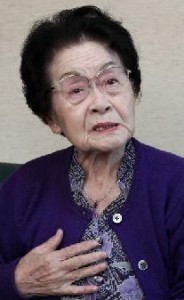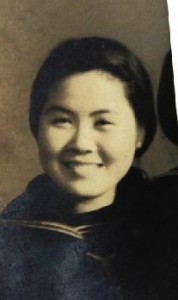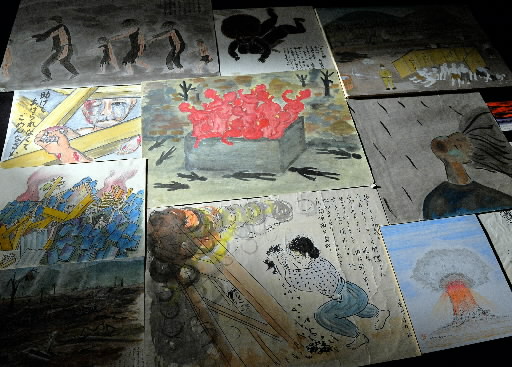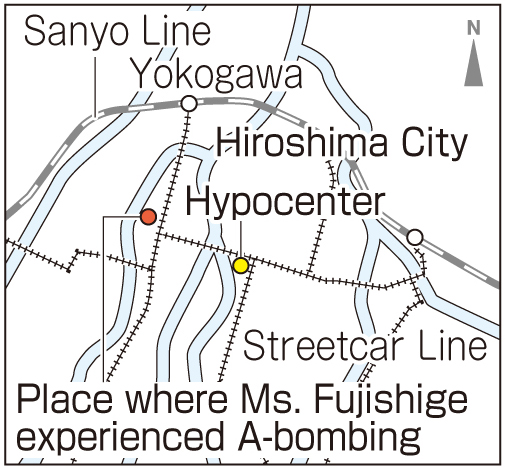Tadako Fujishige, 88, Nishi Ward, Hiroshima
Nov. 7, 2013
Tended to the injured until morning of August 9
Felt no fear, “lost my mind as a human being”
Tadako Fujishige (nee Sogawa), 88, experienced the atomic bombing at the age of 20 while at the West Branch of the Hiroshima Central Telephone Office in Kitaenomachi (part of present-day Naka Ward, Hiroshima), about 1 kilometer from the hypocenter. Luckily, she wasn’t seriously injured and she remained there at her workplace until the morning of August 9, three days after the bombing, to help tend to the wounded. Even now, the moans of those whose skin had been hideously burned, pleading for water, still echo in her ears.
A few years after graduating from a girl’s school, Ms. Fujishige began working at the Hiroshima Central Telephone Office as a member of the women’s volunteer corps. When the atomic bomb exploded on the morning of August 6, 1945, she was performing a desk job at the West Branch, on the third floor of the building. At the moment she stood to search for some papers, turning her back to the window, the blast occurred, slamming into her from behind. The blast was so powerful that it tore off a fire shutter from the window.
The shutter pinned her to the floor, but she managed to struggle out. She helped a coworker who was trapped under a large safe, and they fled desperately from the building. But the coworker was injured, so she returned to the building to get a first-aid kit and then plunged in to help nurse the wounded.
She took her coworker to a portion of the West Branch that had survived the fire, and laid this person in the night watchman’s room. In the room were several others who had fled from her office or from the surrounding neighborhood. Ms. Fujishige passed the night there, fanning off the flies that swarmed the wounded. Recalling that night, she said, “I didn’t feel scared or sad. I had lost my mind as a human being.”
On the morning of August 7, Ms. Fujishige’s mother, who experienced the bombing while in a field near their house in Oshiba-cho (part of present-day Nishi Ward), came to the Hiroshima Central Telephone Office with her father, in search of Ms. Fujishige. However, she told her parents that she couldn’t leave the wounded, and so didn’t return home at that time.
Her injured coworker was taken home by her parents. The coworker bowed over and over to express her gratitude for Ms. Fujishige’s help. “You saved my life,” she said.
Ms. Fujishige also has a painful memory that she is unable to forget. A girl whose head was badly injured was put into a truck loaded with dead bodies. Ms. Fujishige appealed to the soldiers, “Please stop! She’s still alive!” But the soldiers didn’t listen to her and the girl’s mother arrived just after the truck had gone. Ms. Fujishige couldn’t bear telling the truth to the girl’s mother, so she said instead, “She ran off in that direction.” Even now, when the memory surfaces, her heart feels a deep pang of regret.
Later, Ms. Fujishige herself suffered symptoms of radiation sickness, including bloody stools, hair loss, and black spots on her body. At the time, she wished for death, feeling bitterness toward the United States, the nation that had dropped the A-bomb.
In 1948, she married a master of calligraphy. Her husband passed away in 1991. In August 2013, she underwent surgery for cancer, but now she is back on her feet and living with one of her sons and his family.
In 2005, she contributed eight pictures of terrible scenes of the atomic bombing that she had drawn to Hiroshima Peace Memorial Museum. “I want to convey the message to the next generation that we should never, ever engage in another war,” she said. “Peace is born when people get along together. I want everyone to have compassion.” (Sakiko Masuda, Staff Writer)
A-bomb Drawings by Survivors: Hiroshima Peace Memorial Museum holds more than 4,000 pictures
Pictures include someone with severe burns, fleeing with arms outstretched; a dying mother holding her baby in her arms; and a child trapped under the wreckage of a building. As of the end of September 2013, A-bomb survivors have depicted their experiences in 4,256 works of art that are stored at Hiroshima Peace Memorial Museum.
Attached to each picture are captions which explain the cruel A-bomb scenes, including such messages to the victims as “I’m sorry that I wasn’t able to help you.”
An initial picture drawn by a survivor led to a campaign carried out by NHK (Japan Broadcasting Corporation), in 1974-75, where the call was made for survivors to hand down their experiences through drawings. In all, 2,225 pictures were submitted at this time.
In 2002, the Hiroshima City government and the Chugoku Shimbun took up the campaign and 1,338 new pieces were collected. Separate from the campaign, other pictures were also donated to Peace Memorial Museum.
With the consent of the artists, the pictures are posted on the museum’s website. And in the museum each year, the pictures are put on display in special exhibits under such themes as “Mother and Child” and “Black Rain.” A curator at the museum, Kayo Takahashi, 30, said, “I hope viewers feel the survivors’ anger, grief, and mourning for the victims when they look at these pictures.”
Teenagers’ Impressions
Reminder to appreciate parents
Although Ms. Fujishige lost a precious friend to the atomic bombing, and suffered from A-bomb disease, she has struggled to go on living. She told us, “Please appreciate your parents, who gave you life,” and this reminded me of how much I owe them. Without my parents and their support, I wouldn’t be happy today. More than ever, I want to cherish my parents and express my heartfelt gratitude to them. (Marina Misaki, 14)
Learning about the horror of war
Ms. Fujishige’s story of her A-bomb experience made me cry. I learned about the horror of war, which deprives people of their normal minds as human beings, and I thought, basically, that we should never, ever have another war. I’ll also keep in mind her words, “There’s nothing right about killing people in war.”
When I work as a guide at Peace Memorial Park, which is a school activity, I want to convey the cruelty of the atomic bombing that I heard from Ms. Fujishige. (Yumi Kimura, 17)
Staff Writer’s Notebook
On the basement floor of Hiroshima Peace Memorial Museum, an exhibition titled “Trapped in the Flames” is now being held. Among the pictures on display, made by a number of A-bomb survivors, is a drawing by Ms. Fujishige entitled “It’s Not a Movie! It’s a Fact!” The image shows people who fled from the flames, into the river, and are now drifting away on the water—a depiction of a cruel scene from the day of the A-bombing. The exhibition will continue until December 25.
Ms. Fujishige has also donated seven other pictures to the museum. In those images, she depicted such scenes as a man trying to remove a 1.5-meter-long beam from atop his elderly wife’s chest, a horse that was burned as it tried to flee, and numerous bodies of the victims. The vivid scenes were witnessed by Ms. Fujishige in the aftermath of the blast, about one kilometer from the hypocenter.
As mentioned above, the museum holds more than 4,000 pictures created by survivors. I heard that some survivors have felt deep distress about drawing these images, but their desire to convey their experiences to others has motivated them to continue, even vomiting as they worked. Few photographs were taken on August 6 in the city center, so the reality of what happened under the mushroom cloud is seared into people’s minds through these drawings. (Sakiko Masuda)
(Originally published on October 28, 2013)
Felt no fear, “lost my mind as a human being”
Tadako Fujishige (nee Sogawa), 88, experienced the atomic bombing at the age of 20 while at the West Branch of the Hiroshima Central Telephone Office in Kitaenomachi (part of present-day Naka Ward, Hiroshima), about 1 kilometer from the hypocenter. Luckily, she wasn’t seriously injured and she remained there at her workplace until the morning of August 9, three days after the bombing, to help tend to the wounded. Even now, the moans of those whose skin had been hideously burned, pleading for water, still echo in her ears.
A few years after graduating from a girl’s school, Ms. Fujishige began working at the Hiroshima Central Telephone Office as a member of the women’s volunteer corps. When the atomic bomb exploded on the morning of August 6, 1945, she was performing a desk job at the West Branch, on the third floor of the building. At the moment she stood to search for some papers, turning her back to the window, the blast occurred, slamming into her from behind. The blast was so powerful that it tore off a fire shutter from the window.
The shutter pinned her to the floor, but she managed to struggle out. She helped a coworker who was trapped under a large safe, and they fled desperately from the building. But the coworker was injured, so she returned to the building to get a first-aid kit and then plunged in to help nurse the wounded.
She took her coworker to a portion of the West Branch that had survived the fire, and laid this person in the night watchman’s room. In the room were several others who had fled from her office or from the surrounding neighborhood. Ms. Fujishige passed the night there, fanning off the flies that swarmed the wounded. Recalling that night, she said, “I didn’t feel scared or sad. I had lost my mind as a human being.”
On the morning of August 7, Ms. Fujishige’s mother, who experienced the bombing while in a field near their house in Oshiba-cho (part of present-day Nishi Ward), came to the Hiroshima Central Telephone Office with her father, in search of Ms. Fujishige. However, she told her parents that she couldn’t leave the wounded, and so didn’t return home at that time.
Her injured coworker was taken home by her parents. The coworker bowed over and over to express her gratitude for Ms. Fujishige’s help. “You saved my life,” she said.
Ms. Fujishige also has a painful memory that she is unable to forget. A girl whose head was badly injured was put into a truck loaded with dead bodies. Ms. Fujishige appealed to the soldiers, “Please stop! She’s still alive!” But the soldiers didn’t listen to her and the girl’s mother arrived just after the truck had gone. Ms. Fujishige couldn’t bear telling the truth to the girl’s mother, so she said instead, “She ran off in that direction.” Even now, when the memory surfaces, her heart feels a deep pang of regret.
Later, Ms. Fujishige herself suffered symptoms of radiation sickness, including bloody stools, hair loss, and black spots on her body. At the time, she wished for death, feeling bitterness toward the United States, the nation that had dropped the A-bomb.
In 1948, she married a master of calligraphy. Her husband passed away in 1991. In August 2013, she underwent surgery for cancer, but now she is back on her feet and living with one of her sons and his family.
In 2005, she contributed eight pictures of terrible scenes of the atomic bombing that she had drawn to Hiroshima Peace Memorial Museum. “I want to convey the message to the next generation that we should never, ever engage in another war,” she said. “Peace is born when people get along together. I want everyone to have compassion.” (Sakiko Masuda, Staff Writer)
Hiroshima Insight
A-bomb Drawings by Survivors: Hiroshima Peace Memorial Museum holds more than 4,000 pictures
Pictures include someone with severe burns, fleeing with arms outstretched; a dying mother holding her baby in her arms; and a child trapped under the wreckage of a building. As of the end of September 2013, A-bomb survivors have depicted their experiences in 4,256 works of art that are stored at Hiroshima Peace Memorial Museum.
Attached to each picture are captions which explain the cruel A-bomb scenes, including such messages to the victims as “I’m sorry that I wasn’t able to help you.”
An initial picture drawn by a survivor led to a campaign carried out by NHK (Japan Broadcasting Corporation), in 1974-75, where the call was made for survivors to hand down their experiences through drawings. In all, 2,225 pictures were submitted at this time.
In 2002, the Hiroshima City government and the Chugoku Shimbun took up the campaign and 1,338 new pieces were collected. Separate from the campaign, other pictures were also donated to Peace Memorial Museum.
With the consent of the artists, the pictures are posted on the museum’s website. And in the museum each year, the pictures are put on display in special exhibits under such themes as “Mother and Child” and “Black Rain.” A curator at the museum, Kayo Takahashi, 30, said, “I hope viewers feel the survivors’ anger, grief, and mourning for the victims when they look at these pictures.”
Teenagers’ Impressions
Reminder to appreciate parents
Although Ms. Fujishige lost a precious friend to the atomic bombing, and suffered from A-bomb disease, she has struggled to go on living. She told us, “Please appreciate your parents, who gave you life,” and this reminded me of how much I owe them. Without my parents and their support, I wouldn’t be happy today. More than ever, I want to cherish my parents and express my heartfelt gratitude to them. (Marina Misaki, 14)
Learning about the horror of war
Ms. Fujishige’s story of her A-bomb experience made me cry. I learned about the horror of war, which deprives people of their normal minds as human beings, and I thought, basically, that we should never, ever have another war. I’ll also keep in mind her words, “There’s nothing right about killing people in war.”
When I work as a guide at Peace Memorial Park, which is a school activity, I want to convey the cruelty of the atomic bombing that I heard from Ms. Fujishige. (Yumi Kimura, 17)
Staff Writer’s Notebook
On the basement floor of Hiroshima Peace Memorial Museum, an exhibition titled “Trapped in the Flames” is now being held. Among the pictures on display, made by a number of A-bomb survivors, is a drawing by Ms. Fujishige entitled “It’s Not a Movie! It’s a Fact!” The image shows people who fled from the flames, into the river, and are now drifting away on the water—a depiction of a cruel scene from the day of the A-bombing. The exhibition will continue until December 25.
Ms. Fujishige has also donated seven other pictures to the museum. In those images, she depicted such scenes as a man trying to remove a 1.5-meter-long beam from atop his elderly wife’s chest, a horse that was burned as it tried to flee, and numerous bodies of the victims. The vivid scenes were witnessed by Ms. Fujishige in the aftermath of the blast, about one kilometer from the hypocenter.
As mentioned above, the museum holds more than 4,000 pictures created by survivors. I heard that some survivors have felt deep distress about drawing these images, but their desire to convey their experiences to others has motivated them to continue, even vomiting as they worked. Few photographs were taken on August 6 in the city center, so the reality of what happened under the mushroom cloud is seared into people’s minds through these drawings. (Sakiko Masuda)
(Originally published on October 28, 2013)










